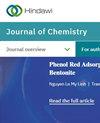Fixed-Bed Adsorption of an Azo Dye (Methyl Orange) onto Chemically and Thermally Regenerated Activated Carbons
IF 2.6
4区 化学
Q2 CHEMISTRY, MULTIDISCIPLINARY
引用次数: 0
Abstract
In this study, the effectiveness of the recovery method for spent granular activated carbon (SGAC) for application in dye removal was evaluated. A comparative study of the textural (porosity), compositional, surface functionality, and adsorption performance of chemically (CAR400) and thermally regenerated activated carbons (CAR700 and CAR900) was conducted for the elimination of methyl orange (MO) dye by using a fixed-bed system. The results were compared with those of commercial activated carbon (CA). The influence of parameters such as the initial dye concentration, the flow rate, the internal diameter of the column, and the bed height was evaluated. Adsorption data were modelled by using the Thomas, Adams–Bohart, and Yoon–Nelson equations. The CAR400 activated carbon had a microporosity (1045 mg/g) comparable to that of the reference commercial (CA) activated carbon (1052 mg/g) but exhibited the least adsorption capacity. The breakthrough curves were best described by the Thomas model more than the Bohart–Adams and Yoon–Nelson’s models. Thomas’s model depicted that an increase in column diameter resulted in a decrease in the maximum adsorption capacity (qo). The CAR900 material exhibited the highest adsorption capacity (15.72 mg/g) comparable to that of commercial activated carbon, CA (16.90 mg/g). These results show that the physical/thermal regeneration of spent granular activated carbons (SGAC) is more suitable for the valorization of these waste materials for water purification applications.化学再生和热再生活性炭对偶氮染料(甲基橙)的固定床吸附作用
本研究评估了废颗粒活性碳(SGAC)回收法在去除染料方面的应用效果。在使用固定床系统去除甲基橙(MO)染料时,对化学再生活性碳(CAR400)和热再生活性碳(CAR700 和 CAR900)的质地(孔隙率)、成分、表面功能和吸附性能进行了比较研究。研究结果与商用活性炭(CA)进行了比较。评估了初始染料浓度、流速、色谱柱内径和床层高度等参数的影响。使用托马斯、亚当斯-波哈特和尹-尼尔森方程对吸附数据进行建模。CAR400 活性炭的微孔率(1045 毫克/克)与参考商用(CA)活性炭的微孔率(1052 毫克/克)相当,但吸附能力最低。与 Bohart-Adams 和 Yoon-Nelson 模型相比,Thomas 模型对突破曲线的描述最为准确。托马斯模型表明,柱直径的增加会导致最大吸附容量(qo)的降低。CAR900 材料的吸附容量最高(15.72 毫克/克),与商用活性炭 CA 的吸附容量(16.90 毫克/克)相当。这些结果表明,废颗粒活性碳(SGAC)的物理/热再生更适合用于水净化应用中的废旧材料的价值评估。
本文章由计算机程序翻译,如有差异,请以英文原文为准。
求助全文
约1分钟内获得全文
求助全文
来源期刊

Journal of Chemistry
CHEMISTRY, MULTIDISCIPLINARY-
CiteScore
5.90
自引率
3.30%
发文量
345
审稿时长
16 weeks
期刊介绍:
Journal of Chemistry is a peer-reviewed, Open Access journal that publishes original research articles as well as review articles in all areas of chemistry.
 求助内容:
求助内容: 应助结果提醒方式:
应助结果提醒方式:


